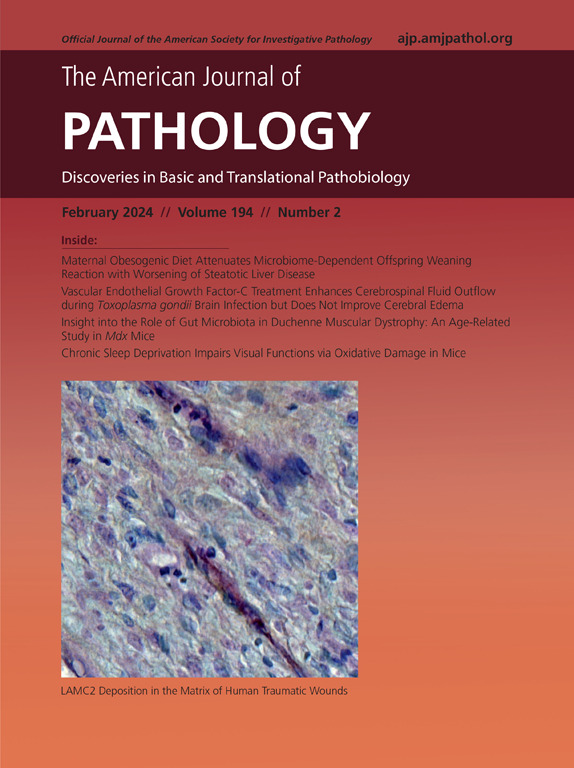Leucine-Rich Repeat Kinase 2 Promotes Disintegration of Retinal Pigment Epithelial Cell
IF 4.7
2区 医学
Q1 PATHOLOGY
引用次数: 0
Abstract
Recent epidemiologic studies have shown that patients with age-related macular degeneration (AMD) have a considerably higher risk of developing Parkinson disease (PD) later in life, suggesting a possible link between these diseases. However, the common mechanisms between these two diseases remain obscure, although the pathophysiology of each has been well investigated. This study was designed to explore the shared pathologic features of AMD and PD by focusing on leucine-rich repeat kinase 2 (LRRK2) and α-synuclein, both of which play crucial roles in PD pathogenesis. Immunohistochemistry for LRRK2 and α-synuclein was performed on human eye specimens. The effect of LRRK2 on retinal pigment epithelium (RPE) cell function was investigated using the RPE cell line hTERT-RPE1. Retinal morphology and function were examined in LRRK2-G2019S transgenic mice, representing mutants with increased kinase activity of LRRK2. Immunohistochemistry revealed that LRRK2 and α-synuclein were present in the RPE layer of the human eye. Overexpression of LRRK2 in RPE cells increased α-synuclein and induced cell death. LRRK2 inhibited α-synuclein degradation via phosphorylation of RAB, member RAS oncogene GTPases. LRRK2-G2019S transgenic mice exhibited apoptosis of RPE and photoreceptors, choroidal thinning, and reduced electroretinogram amplitude, on top of α-synuclein protein accumulation in the RPE cell layer. Taken together, the current study revealed that LRRK2 is one of the key molecules involved in the common pathologic mechanisms of AMD and PD.

富亮氨酸重复激酶2促进视网膜色素上皮细胞的解体:干性年龄相关性黄斑变性发病机制的意义。
最近的流行病学研究表明,年龄相关性黄斑变性(AMD)患者在以后的生活中患帕金森病(PD)的风险相当高,这表明这些疾病之间可能存在联系。然而,这两种疾病之间的共同机制仍然不清楚,尽管每一种疾病的病理生理学已经得到了很好的研究。在本研究中,我们试图通过关注富亮氨酸重复激酶2 (LRRK2)和α-突触核蛋白来探索AMD和PD的共同病理特征,这两个蛋白在PD的发病机制中都起着至关重要的作用。对人眼标本进行LRRK2和α-突触核蛋白的免疫组化。采用RPE细胞系hTERT-RPE1研究LRRK2对RPE细胞功能的影响。检测LRRK2- g2019s转基因小鼠视网膜形态和功能,LRRK2激酶活性增加。免疫组化结果显示,LRRK2和α-突触核蛋白存在于人眼RPE层。LRRK2在RPE细胞中过表达增加α-突触核蛋白,诱导细胞死亡。LRRK2通过磷酸化RAB gtpase抑制α-突触核蛋白降解。LRRK2-G2019S转基因小鼠在RPE细胞层α-突触核蛋白积累的基础上,表现出RPE和光感受器凋亡、脉络膜变薄、视网膜电图振幅降低。综上所述,本研究表明LRRK2是参与AMD和PD共同病理机制的关键分子之一。
本文章由计算机程序翻译,如有差异,请以英文原文为准。
求助全文
约1分钟内获得全文
求助全文
来源期刊
CiteScore
11.40
自引率
0.00%
发文量
178
审稿时长
30 days
期刊介绍:
The American Journal of Pathology, official journal of the American Society for Investigative Pathology, published by Elsevier, Inc., seeks high-quality original research reports, reviews, and commentaries related to the molecular and cellular basis of disease. The editors will consider basic, translational, and clinical investigations that directly address mechanisms of pathogenesis or provide a foundation for future mechanistic inquiries. Examples of such foundational investigations include data mining, identification of biomarkers, molecular pathology, and discovery research. Foundational studies that incorporate deep learning and artificial intelligence are also welcome. High priority is given to studies of human disease and relevant experimental models using molecular, cellular, and organismal approaches.

 求助内容:
求助内容: 应助结果提醒方式:
应助结果提醒方式:


